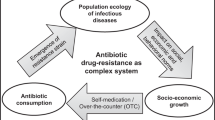Abstract
Antibiotic overuse has promoted the spread of antibiotic resistance. To compound the issue, treating individuals dually infected with antibiotic-resistant and antibiotic-vulnerable strains can make their infections completely resistant through competitive release. We formulate mathematical models of transmission dynamics accounting for dual infections and extensions accounting for lag times between infection and treatment or between cure and ending treatment. Analysis using the Next-Generation Matrix reveals how competition within hosts and the costs of resistance determine whether vulnerable and resistant strains persist, coexist, or drive each other to extinction. Invasion analysis predicts that treatment of dually infected cases will promote resistance. By varying antibiotic strength, the models suggest that physicians have two ways to achieve a particular resistance target: prescribe relatively weak antibiotics to everyone infected with an antibiotic-vulnerable strain or give more potent prescriptions to only those patients singly infected with the vulnerable strain after ruling out the possibility of them being dually infected with resistance. Through selectivity and moderation in antibiotic prescription, resistance might be limited.








Similar content being viewed by others
References
Alizon S (2013) Co-infection and super-infection models in evolutionary epidemiology. Interface Focus 3(6):20130031
Andersson DI, Hughes D (2011) Persistence of antibiotic resistance in bacterial populations. FEMS Microbiol Rev 35(5):901–911
Balmer O, Tanner M (2011) Prevalence and implications of multiple-strain infections. Lancet Infect Dis 11(11):868–878
Birger RB, Kouyos RD, Cohen T, Griffiths EC, Huijben S, Mina M, Volkova V, Grenfell B, Metcalf CJE (2015) The potential impact of coinfection on antimicrobial chemotherapy and drug resistance. Trends Microbiol 23(9):537–544
Björkman J, Andersson DI (2000) The cost of antibiotic resistance from a bacterial perspective. Drug Resist Updates 3(4):237–245
Cohen T, Lipsitch M, Walensky RP, Murray M (2006) Beneficial and perverse effects of isoniazid preventive therapy for latent tuberculosis infection in HIV–tuberculosis coinfected populations. Proc Natl Acad Sci USA 103(18):7042–7047
Colijn C, Cohen T (2015) How competition governs whether moderate or aggressive treatment minimizes antibiotic resistance. eLife 4:e10,559
Colijn C, Cohen T, Fraser C, Hanage W, Goldstein E, Givon-Lavi N, Dagan R, Lipsitch M (2009) What is the mechanism for persistent coexistence of drug-susceptible and drug-resistant strains of Streptococcus pneumoniae? J R Soc Interface 7(47):905–919
Day T, Huijben S, Read AF (2015) Is selection relevant in the evolutionary emergence of drug resistance? Trends Microbiol 23(3):126–133
Day T, Read AF (2016) Does high-dose antimicrobial chemotherapy prevent the evolution of resistance? PLoS Comput Biol 12(1):1–20
Dieckmann O, Heesterbeek A, Roberts M (2010) The construction of next-generation matrices for compartmental epidemic models. J R Soc Interface 7(47):873–885
Hansen J, Day T (2014) Coinfection and the evolution of drug resistance. J Evol Biol 27(12):2595–2604. doi:10.1111/jeb.12518
Huijben S, Bell AS, Sim DG, Tomasello D, Mideo N, Day T, Read AF (2013) Aggressive chemotherapy and the selection of drug resistant pathogens. PLoS Pathogens 9(9):e1003578. doi:10.1371/journal.ppat.1003578
Levin B, Lipsitch M, Perrot V, Schrag S, Antia R, Simonsen L, Walker NM, Stewart F (1997) The population genetics of antibiotic resistance. Clin Infect Dis 24(Supplement 1):S9–S16
Lipsitch M, Bergstrom CT, Levin BR (2000) The epidemiology of antibiotic resistance in hospitals: paradoxes and prescriptions. Proc Natl Acad Sci USA 97(4):1938–1943
Lipsitch M, Colijn C, Cohen T, Hanage WP, Fraser C (2009) No coexistence for free: neutral null models for multistrain pathogens. Epidemics 1(1):2–13
May RM, Nowak MA (1995) Coinfection and the evolution of parasite virulence. Proc R Soc Lond B Biol Sci 261(1361):209–215
Mosquera J, Adler FR (1998) Evolution of virulence: a unified framework for coinfection and superinfection. J Theor Biol 195(3):293–313
Peña-Miller R, Lähnemann D, Schulenburg H, Ackermann M, Beardmore R (2012) Selecting against antibiotic-resistant pathogens: optimal treatments in the presence of commensal bacteria. Bull Math Biol 74(4):908–934
R Core Team (2014) R: a language and environment for statistical computing. R Foundation for Statistical Computing, Vienna. http://www.R-project.org/
Read AF, Day T, Huijben S (2011) The evolution of drug resistance and the curious orthodoxy of aggressive chemotherapy. Proc Natl Acad Sci USA 108(Supplement 2):10,871–10,877
Smith DL, Harris AD, Johnson JA, Silbergeld EK, Morris JG (2002) Animal antibiotic use has an early but important impact on the emergence of antibiotic resistance in human commensal bacteria. Proc Natl Acad Sci USA 99(9):6434–6439
Soetaert K, Petzoldt T, Setzer RW (2010) Solving differential equations in R: package deSolve. J Stat Softw 33(9):1–25. http://www.jstatsoft.org/v33/i09
Spicknall IH, Foxman B, Marrs CF, Eisenberg JN (2013) A modeling framework for the evolution and spread of antibiotic resistance: literature review and model categorization. Am J Epidemiol 178(4):508–520
Ternent L, Dyson RJ, Krachler AM, Jabbari S (2015) Bacterial fitness shapes the population dynamics of antibiotic-resistant and-susceptible bacteria in a model of combined antibiotic and anti-virulence treatment. J Theor Biol 372:1–11
Urbanek S (2014) jpeg: read and write JPEG images. http://CRAN.R-project.org/package=jpeg, R package version 0.1-8
van Baalen M, Sabelis MW (1995) The dynamics of multiple infection and the evolution of virulence. Am Nat 146:881–910
van den Driessche P, Watmough J (2002) Reproduction numbers and sub-threshold endemic equilibria for compartmental models of disease transmission. Math Biosci 180:29–48
Van Effelterre T, Moore MR, Fierens F, Whitney CG, White L, Pelton SI, Hausdorff WP (2010) A dynamic model of pneumococcal infection in the United States: implications for prevention through vaccination. Vaccine 28(21):3650–3660
Wickham H (2009) ggplot2: elegant graphics for data analysis. Springer, New York. http://had.co.nz/ggplot2/book
Author information
Authors and Affiliations
Corresponding author
Rights and permissions
About this article
Cite this article
Beams, A.B., Toth, D.J.A., Khader, K. et al. Harnessing Intra-Host Strain Competition to Limit Antibiotic Resistance: Mathematical Model Results. Bull Math Biol 78, 1828–1846 (2016). https://doi.org/10.1007/s11538-016-0201-1
Received:
Accepted:
Published:
Issue Date:
DOI: https://doi.org/10.1007/s11538-016-0201-1




